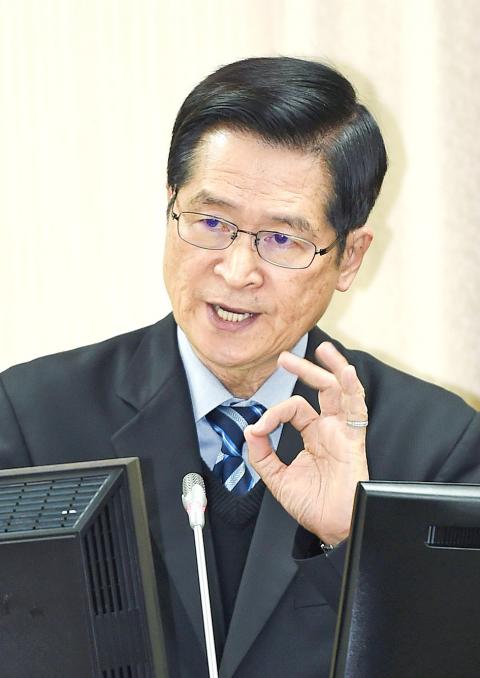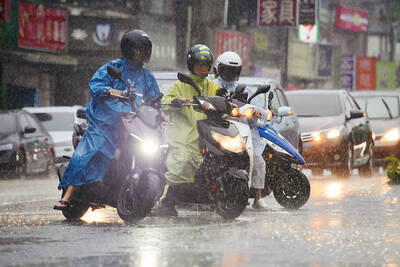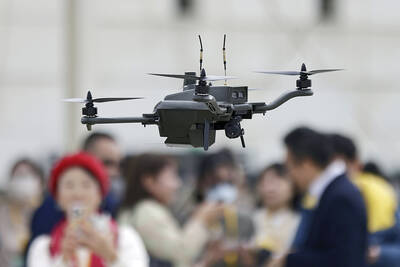The nation’s armed forces can hold the line against China’s People’s Liberation Army (PLA), Minister of National Defense Yen De-fa (嚴德發) yesterday told the Legislative Yuan’s Foreign Affairs and National Defense Committee.
During a question-and-answer session, Yen was asked to evaluate the comparative military capabilities of Taiwan and China, three days after President Tsai Ing-wen (蔡英文) told CNN that Taiwan was “capable of holding off any first waves of attacks” by China.
Democratic Progressive Party (DPP) Legislator Lo Chih-cheng (羅致政) asked what the military’s capabilities were to respond to a PLA “first strike,” and whether it had the ability to mount a pre-emptive strike against China.

Photo: Fang Pin-chao, Taipei Times
The nation’s two-staged military doctrine is to enact force protection, followed by the deployment of combat power, Yen told Lo.
“For force protection, we must be capable of absorbing the first strike, so critical and dependable forces are mechanized, and they will not stay still for the enemy to hit,” he said. “For deploying combat power, we will use counterattacks and early suppression of the enemy, as well as other actions.”
“As for pre-emptive capabilities, we possess them, but we are not at liberty to discuss them,” he said.
However, he added that those capabilities are for creating a multi-layered deterrence, not for launching first strikes.
When DPP Legislator Wu Kun-yuh (吳焜裕) asked Yen to elaborate on the national military doctrine, the minister said Taiwan was not engaged in an arms race with China and the military relies on quality to overcome quantity.
To augment force protection, the ministry is working with local governments to mobilize assets necessary to protect military installations against Chinese guided missiles, in conjunction with concealment and mobility measures, he said.
The armed forces would deploy mobile and decisive weapons systems to fight at the place and time of its choosing, with an emphasis on using the terrain to maximize asymmetric warfare capabilities in the counter-air, counter-naval and counter-amphibious operational phases of such a war, Yen said.
Chinese Nationalist Party (KMT) Legislator William Tseng (曾銘宗) asked Yen to gauge the time the military could hold out against the PLA, and what the armed forces would do if war broke out as the result of political conflict between independence and unification factions.
While the military does not quantify defensive time frames for doctrinal reasons, “we have full confidence and capability to stay on top of regional developments and defend our homeland,” Yen said.
The military’s core value is its constitutional duty to defend the Republic of China and the citizens residing within its domain, he said.
The US is certain to intervene if regional security developments threaten its national interests and Japan could possibly be involved, he said, adding that the ministry could not speak for the intentions of the Philippines.

The combined effect of the monsoon, the outer rim of Typhoon Fengshen and a low-pressure system is expected to bring significant rainfall this week to various parts of the nation, the Central Weather Administration (CWA) said. The heaviest rain is expected to occur today and tomorrow, with torrential rain expected in Keelung’s north coast, Yilan and the mountainous regions of Taipei and New Taipei City, the CWA said. Rivers could rise rapidly, and residents should stay away from riverbanks and avoid going to the mountains or engaging in water activities, it said. Scattered showers are expected today in central and

COOPERATION: Taiwan is aligning closely with US strategic objectives on various matters, including China’s rare earths restrictions, the Ministry of Foreign Affairs said Taiwan could deal with China’s tightened export controls on rare earth metals by turning to “urban mining,” a researcher said yesterday. Rare earth metals, which are used in semiconductors and other electronic components, could be recovered from industrial or electronic waste to reduce reliance on imports, National Cheng Kung University Department of Resources Engineering professor Lee Cheng-han (李政翰) said. Despite their name, rare earth elements are not actually rare — their abundance in the Earth’s crust is relatively high, but they are dispersed, making extraction and refining energy-intensive and environmentally damaging, he said, adding that many countries have opted to

SUPPLY CHAIN: Taiwan’s advantages in the drone industry include rapid production capacity that is independent of Chinese-made parts, the economic ministry said The Executive Yuan yesterday approved plans to invest NT$44.2 billion (US$1.44 billion) into domestic production of uncrewed aerial vehicles over the next six years, bringing Taiwan’s output value to more than NT$40 billion by 2030 and making the nation Asia’s democratic hub for the drone supply chain. The proposed budget has NT$33.8 billion in new allocations and NT$10.43 billion in existing funds, the Ministry of Economic Affairs said. Under the new development program, the public sector would purchase nearly 100,000 drones, of which 50,898 would be for civil and government use, while 48,750 would be for national defense, it said. The Ministry of

UNITED: The other candidates congratulated Cheng on her win, saying they hoped the new chair could bring the party to victory in the elections next year and in 2028 Former Chinese Nationalist Party (KMT) lawmaker Cheng Li-wun (鄭麗文) yesterday won the party’s chair election with 65,122 votes, or 50.15 percent of the votes. It was the first time Cheng, 55, ran for the top KMT post, and she is the second woman to hold the post of chair, following Hung Hsiu-chu (洪秀柱), who served from 2016 to 2017. Cheng is to succeed incumbent Eric Chu (朱立倫) on Nov. 1 for a four-year term. Cheng said she has spoken with the other five candidates and pledged to maintain party unity, adding that the party would aim to win the elections next year and